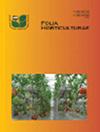Investigation of stem anatomy in relation to hydraulic conductance, vegetative growth and yielding potential of ‘Summit’ cherry trees grafted on different rootstock candidates
IF 1.8
4区 农林科学
Q2 HORTICULTURE
引用次数: 4
Abstract
Abstract Severe climate alterations that seriously challenge fruit production, combined with the demand for healthy, pesticide-free fruits, continuously direct rootstock/cultivar selection towards high adaptable varieties breeding. This study aimed to investigate the rootstocks’ influence on the performance of grafted ‘Summit’ cherry trees, including potentially dwarfing Prunus cerasus, Prunus fruticosa and Prunus mahaleb rootstock candidates. Anatomical properties of rootstock and scion stems were investigated to determine variation among different rootstocks and scion-rootstock combinations and to establish the link between trunk hydraulic conductivity, effective tree crown volume and yielding potential. Cross-section anatomical characteristics varied significantly both in rootstock and scion stems, indicating a clear influence of rootstock genotype on grafted sweet cherry trees. It was observed that all investigated cherry rootstock candidates belong to the low-vigorous rootstocks, based on the estimated effective crown volume of grafted trees compared to ‘Gisela 5’, with values ranging from 0.86 to 2.97 m3 in the fifth year after planting. Results showed a statistically significant positive correlation between trunk hydraulic conductivity, effective tree crown volume and yielding potential, with correlation coefficients up to 0.96. Significantly higher effective crown volume and trunk hydraulic conductance of trees grafted on P. cerasus compared to the trees on control, as well as highest yielding potential, showed better adaptation of these rootstock candidates in the trial without irrigation implemented. It was found that PC_05_04 rootstock candidate could be considered as the most appropriate choice when raising the high-density sweet cherry plantations, due to assessed parameters of vegetative and generative growth.嫁接在不同砧木上的‘峰顶’樱桃树茎解剖与水力导度、营养生长和产量潜力的关系研究
摘要严峻的气候变化对水果生产构成了严峻的挑战,加之人们对健康、无农药水果的需求,不断地将砧木/栽培品种的选择导向高适应性品种的选育。本研究旨在研究砧木对嫁接“峰顶”樱桃树性能的影响,包括潜在矮化的樱桃砧木、樱桃砧木和mahaleb砧木候选砧木。研究了砧木和接穗茎的解剖特性,以确定不同砧木和接穗-砧木组合之间的差异,并建立树干水力导度、有效树冠体积和产量潜力之间的联系。砧木和接穗茎的截面解剖特征差异显著,表明砧木基因型对嫁接的甜樱桃树有明显的影响。结果表明,与“吉塞拉5号”相比,嫁接后第5年的有效树冠体积在0.86 ~ 2.97 m3之间,所有候选砧木均属于低活力砧木。结果表明:树干水力导度、有效树冠体积与产量势呈显著正相关,相关系数达0.96;在不灌水的情况下,嫁接在杉木上的树木的有效树冠体积和树干水力导度显著高于对照,并且具有最高的产量潜力,表明这些候选砧木在不灌水的情况下具有更好的适应性。结果表明,PC_05_04砧木候选品种在高密度甜樱桃人工林栽培中最适宜。
本文章由计算机程序翻译,如有差异,请以英文原文为准。
求助全文
约1分钟内获得全文
求助全文
来源期刊

Folia Horticulturae
Agricultural and Biological Sciences-Horticulture
CiteScore
3.40
自引率
0.00%
发文量
13
审稿时长
16 weeks
期刊介绍:
Folia Horticulturae is an international, scientific journal published in English. It covers a broad research spectrum of aspects related to horticultural science that are of interest to a wide scientific community and have an impact on progress in both basic and applied research carried out with the use of horticultural crops and their products. The journal’s aim is to disseminate recent findings and serve as a forum for presenting views as well as for discussing important problems and prospects of modern horticulture, particularly in relation to sustainable production of high yield and quality of horticultural products, including their impact on human health.
 求助内容:
求助内容: 应助结果提醒方式:
应助结果提醒方式:


